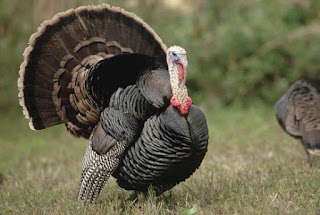Turkey
bird
Alternative Title:
Meleagrididae
Turkey, either of two species of birds classified as members of either the family Phasianidae or Meleagrididae (order Galliformes). The best known is the common turkey (Meleagris gallopavo), a native game bird of North America but widely domesticated for the table. The other species is Agriocharis (or Meleagris) ocellata, the ocellated turkey. For unrelated but similar birds, see bustard (Australian turkey); megapode (brush turkey); snakebird (water turkey).
Races of the common turkey found today in Mexico and in the southeastern and southwestern United States differ slightly in feather markings and in rump colour, but all are basically dark, with iridescent bronze and green plumage. Adult males have a naked, heavily carunculated (bumpy) head that is normally bright red in colour but turns to white overlaid with bright blue when the birds are excited. Other distinguishing features of the common turkey are a long red fleshy ornament (called a snood) that grows from the forehead over the bill; a fleshy wattle growing from the throat; a tuft of coarse, black, hairlike feathers (known as a beard) projecting from the breast; and more or less prominent leg spurs. The male turkey, or gobbler, or tom, may be 130 cm (50 inches) long and weigh 10 kg (22 pounds), though average weight is less. Female turkeys, or hens, generally weigh only half as much as the males and have less warty heads than do the males. Domesticated strains of the common turkey, developed for their fine-tasting flesh, may be much heavier.
Roast turkey in many European countries has long been a customary Christmas dish. In the United States the bird is especially associated with the holiday of Thanksgiving. Turkey production has thus tended to be seasonal, though in the United States and some other countries, ready-to-cook lean, boned turkey is available in rolls any time of the year.
The wild turkey prefers woodlands near water. It eats seeds, insects, and an occasional frog or lizard. When alarmed it may run rapidly to cover, but it can fly strongly only for short distances (about 0.4 km, or 0.25 mile). Formerly diminished under hunting pressure, M. gallopavo has come back well under various state game management programs in the United States.

The ocellated turkey, of Central America, is smaller than M. gallopavo. It has a blue head with reddish yellow bumps, bright-tipped feathers, almost peacocklike, and, in addition to the long bill wattle, a yellow-tipped knob on the crown. It has never been domesticated. See also poultry.







No comments:
Post a Comment